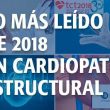Both studies followed beyond 5 years patients with severe aortic stenosis who had undergone transcatheter aortic valve replacement (TAVR). Findings included low rates of significant valve degeneration and failure, in both cases. While data on the long-term degeneration of transcatheter-implanted valves are scarce, follow-up from the NOTION trial of low-risk patients and from the UK TAVI...
The Most Important Articles of 2018 in Structural Heart Diseases
1- ESC 2018 | MITRA FR: Testing MitraClip for Secondary Mitral Regurgitation In secondary mitral regurgitation, mitral-valve leaflets and chordae are structurally normal and mitral regurgitation results from alterations in left ventricular geometry and function. Read more 2- TCT 2018 | COAPT: MitraClip in Patients with Secondary Mitral Regurgitation The prognosis of patients with...
Balloon-Expandable vs. Self-Expanding: To Each Valve Its Own Annulus
The former generation of valves, the balloon expandable (Sapien XT), was associated to less paravalvular leak than the self-expanding valves only in patients with larger annuli. The new generation of self-expanding valves (Evolut R) has managed to significantly improve sealing in patients with larger annuli and still holds potential benefits for smaller annuli. The aim...
TAVR in Low-Risk Patients with “Zero” Mortality and “Zero” Stroke
Transcatheter aortic valve replacement (TAVR) is now the standard of care for patients with symptomatic severe aortic stenosis who are at extreme, high, or intermediate risk for surgery. This multicenter, prospective study (Feasibility of Transcatheter Aortic Valve Replacement in Low-Risk Patients With Symptomatic, Severe Aortic Stenosis) included low-risk patients and was approved by the United...
See the presentations of the 9th José Gabay Fellow Course
We are deeply thankful to all interventional physicians who, motivated by their great scientific and educational vocation, presented their works at the “José Gabay” Course. Read the presentations below: Module I: Fundamentals and Basic Elements. Leiva Pons, José Luis. “Vascular Closure Devices. Step by Step.” (Spanish version) García García, Hector. “Current Status of Coronary Intervention:...
More Evidence For MitraClip in High Risk Patients with Severe Tricuspid Regurgitation
Courtesy of Dr. Carlos Fava. Tricuspid regurgitation (TR) has a negative impact in the long run. Several reports have shown that, in high risk inoperable patients, transcatheter edge-to-edge valve repair with MitraClip is feasible, safe and has good results, but there is still a long way to go. The present study looked at 24 consecutive...
MitraClip in Severe MR: 5 Year Mortality Rate Similar to Surgery
Courtesy of Dr. Carlos Fava. Mitral regurgitation accounts for around 25% of valvular diseases and is a strong mortality predictor in heart disease. One of the challenges of this disease is that patients respond favorably to medical treatment for a long time, which makes hard to establish the right time to perform an intervention without...
Urgent/Emergent TAVR: A Valid Option
Courtesy of Dr. Carlos Fava. Aortic stenosis with cardiac failure or cardiogenic shock involves high mortality risk at short term. Surgery in these conditions is often unsafe, which leaves us with valvuloplasty, but only as a bridge to some other procedure, seeing as it is effective only for a short time. Few studies have looked into patients undergoing...
Diastolic Dysfunction Should Be Considered in TAVR
Aortic stenosis increases afterload creating hypertrophy as a compensation mechanism to maintain minute volume. This leads to left ventricular diastolic dysfunction (LVDD). More than half of patients presenting aortic stenosis have LVDD and myocardial fibrosis, which is a mortality predictor in surgery. At present, there is contradicting evidence in TAVR. The study looked...
Coronary Disease Works as a 30-Day Predictor in TAVR
The association between aortic stenosis and coronary disease is common, since both conditions share pathogenesis, risk factors, and symptoms. Transcatheter aortic valve replacement (TAVR) is currently indicated for high-risk and inoperable patients. It also appears as a valid alternative for the treatment of intermediate-risk patients, and it could soon be indicated for low-risk patients. Coronary...








